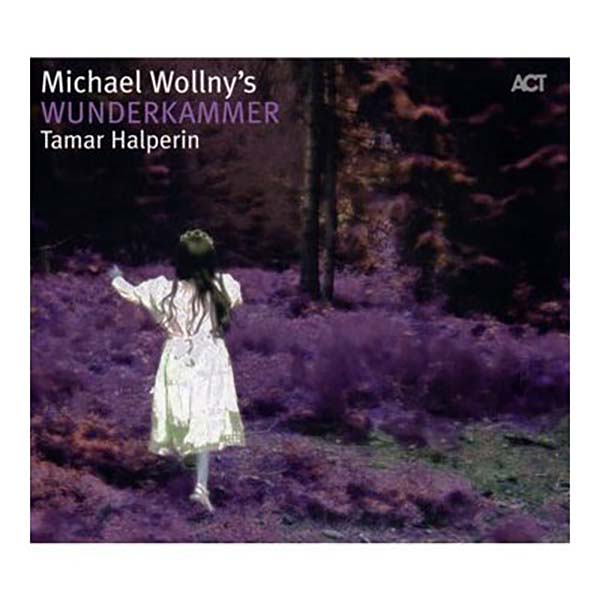
by Ian Mann
October 05, 2009
/ ALBUM
Another highly distinctive offering from a major musical talent
The young German pianist Michael Wollny is nothing if not prolific. He has appeared on these pages as a member of the influential trio {em} with bassist Eva Kruse and drummer Eric Schaefer, as one half of a piano duo with Joachim Kuhn (“Live at Schloss Elmau”) and as a solo artist with his “Gothic” project “Hexentanz”.
If {em} represents the jazzier side of Wollny’s musical personality his solo projects are more of a reflection of his classical leanings. However with Wollny being the creative soul that he is these are explored in interesting and innovative ways. In some respects “Wunderkammer” is similar to “Hexentanz” in that Wollny has an overall mood and concept in mind, in this case an exploration of the magical properties of keyboard instruments both ancient and modern. Thus we hear Wollny not only on piano but also on historic keyboards in the forms of celesta, harpsichord and harmonium. On two tracks he appears on Fender Rhodes bringing the history of the piano right up to date. In this fusion of ancient and modern Wollny is frequently overdubbed and duets with himself but at other times he engages in genuine two way dialogue with Israeli musician Tamar Halperin who specialises in harpsichord and occasional celesta. The role of producer and sometime arranger Guy Sternberg is also crucial to the success of these recordings.
“Wunderkammer” literally means “chamber of curiosities” and although Wollny’s choice of instruments evokes the sounds of a musical museum his music also has a highly contemporary quality. The mood is often ethereal and other worldly as befits the album’s title and “fairy” cover imagery. Often the sound is reminiscent of cuckoo clocks, old musical boxes and other archaic instruments of mechanical music. There is a hint of the Gothic again but the mood here is less intense than on “Hexentanz”. “Wunderkammer” seeks to enchant rather than frighten the listener. .
This it does magnificently over the course of it’s twelve relatively short tracks. The opening “Stundenglas” features an overdubbed Wollny playing grand piano, Rhodes and the delicately ringing celesta. Wollny features himself on the “heavenly” celesta on no fewer than eight pieces which gives a good idea of the album’s intentions.
Six of the pieces are entitled “Kabinett”, literally “rooms in which different things happen.” The first of these to be heard is actually “Kabinett II” a sparkling meeting between Wollny on piano, celesta and occasional harmonium plus Halperin on harpsichord.
The darker “Chur” was jointly arranged by Wollny and producer Sternburg, who also receives credits on the later “Kabinetts” IV and I.
“Wunderkammer” takes it’s title from the secret rooms in castles and monasteries where leaders stored their treasures in Renaissance and Baroque times. All kinds of curios might be found here and the gently chiming “Kabinett III” seems to encapsulate the eccentric charm of these places. Wollny plays the harpsichord parts himself alongside piano and celesta.
“Mesmer” seems to shimmer on the horizon, a duet between Wollny on piano and celesta and Halperin on harpsichord against a backdrop of subliminal harmonium.
Wollny’s interlocking keyboards on “Kabinett IV” have an almost Steve Reich quality at times and contrast well with the following “Palimpsest”, a lyrical piece for solo piano that emphasises the spaces between the notes.
“Kabinett VI” re-unites Wollny with Halperin ( heard here on both harpsichord and celesta) for what is the most contemporary sounding piece on the album. Interlocking Reichsian keyboard patterns combine with freer episodes featuring Rhodes and harmonium.
“Sagee”, at just over six minutes is the lengthiest track on the album, a reflective piano/harpsichord duet between Wollny and Halperin that emphasises the lyrical side of their playing. The piece is named after the 19th C doppelganger figure Emilie Sagee. Halperin’s harpsichord is, in effect, the shadow of Wollny’s piano.
“Kabinett V” is another overdubbing extravaganza with Wollny featuring on piano, harpsichord and celesta. The sound is very contemporary with a single keyboard figure looping throughout the track as Wollny throws in some jazz chords and uses the body of the piano for percussive effects.
“Amethyst” is a brief passage for glacial solo piano, again using the innards of the instrument.
“Kabinett I” closes the album by drawing many of the elements of the album together. Halperin appears on harpsichord, Wollny on piano, celesta and harmonium, the latter providing a kind of subliminal sonic backwash. It’s a charming way to finish an often charming album.
“Wunderkammer’s” blend of ancient and modern, composition and improvisation, early music and jazz sounds like nothing else I’ve ever heard. Wollny has extraordinary musical vision and has created a unique and unified sound world that is an outstanding success on it’s own terms. It’s not jazz in the strictest sense but this music has much to offer the adventurous listener. It’s interlocking patterns and rhythms and unusual timbres make for fascinating and frequently enchanting listening.
The arcane instruments Wollny deploys actually sound fresh, exotic and exciting to jaded 21st century ears. “Wunderkammer” is another highly distinctive offering from an outstanding musical talent.
Wollny undertakes a brief UK tour featuring the Wunderkammer project in November 2009. Dates are;
17/11/2009 Band On The Wall, Manchester
19/11/2009 St George’s, Brandon Hill, Bristol
20/11/2009 Festival at the Pheasantry, Chelsea, London
blog comments powered by Disqus